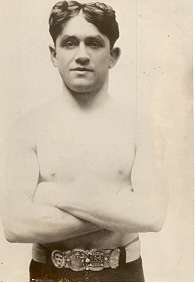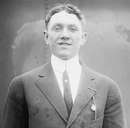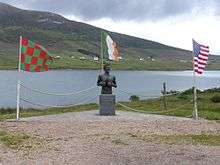Johnny Kilbane
John Patrick "Johnny" Kilbane (April 9, 1889 – May 31, 1957) was a featherweight boxer in the early part of the 20th century. He held the World Featherweight title from 1912 to 1923, the longest period in the division's history, having defended the title against four contenders during the reign.[1][2][3] Statistical boxing website BoxRec lists Kilbane as the #2 ranked featherweight of all-time, while The Ring Magazine founder Nat Fleischer placed him at #5.[4][5] The International Boxing Research Organization rates Kilbane as the 8th best featherweight ever.[6] He was inducted into the Ring Magazine Hall of Fame in 1960 and the International Boxing Hall of Fame in 1995.[4]
| Johnny Kilbane | |
|---|---|
 | |
| Statistics | |
| Real name | John Patrick Kilbane |
| Nickname(s) | Johnny |
| Weight(s) | Featherweight |
| Nationality | United States Of America |
| Born | April 9, 1889 Cleveland, Ohio |
| Died | May 31, 1957 (aged 68) Cleveland, Ohio |
| Boxing record | |
| Total fights | 142 |
| Wins | 110 |
| Wins by KO | 24 |
| Losses | 4 |
| Draws | 15 |
| No contests | 1 |
Early life
Kilbane was born to John and Mary (Gallagher) Kilbane in Cleveland, Ohio on April 9, 1889. His mother died when he was 3 years old and his father went blind when he was 6. He attended school until the sixth grade when he dropped out to help support his family.
Career
Kilbane's first professional fight was in 1907, for which he earned around $25.
World featherweight champion
On February 22, 1912 Kilbane took the featherweight title from Abe Atell in a twenty-round match in Vernon, California. When he returned to Cleveland, on St. Patrick's Day, he was given the greatest welcome ever given to a native Clevelander, with more than 100,000 people turning out. He held the featherweight championship for 11 years through numerous fights. He finally lost it to Eugene Criqui. The high number of "no decision"s in his career reflected early boxing rules in many states in the U.S. that dictated "no decision"—ND—unless a fight ended by knockout.
Kilbane fought 1904 World Bantamweight champion Jimmy Walsh in a World Featherweight Title match on May 21, 1912 at the Pilgrim Athletic Club in Boston, Massachusetts to a twelve-round draw decision.[7] They had previously fought in a non-title match on May 30, 1911, in a 12-round draw bout in Canton, Ohio, that was characterized as "full of clinches", with neither man "doing much hard work."[8]
In October 1917 - while still World Featherweight Champion - Kilbane became a lieutenant in the U.S. Army — assigned to Camp Sherman located near Chillicothe, Ohio — training U.S. soldiers in self-defense during World War I.[9]
After losing the featherweight title in 1923, Kilbane won at least two exhibition bouts, and then retired from boxing.
Life after boxing

Kilbane would referee boxing matches after retiring from boxing, as well as operating a gym, serving in the Ohio Senate and acting as Clerk of the Cleveland Municipal Court.
Kilbane was such a popular prizefighter in his day that his name appeared in print as a verb. An unsigned commentary in the sports pages of the New York Times on May 16, 1912, reported on an episode involving Detroit baseball player Ty Cobb, who the day before, in a game between the Detroit Tigers and the New York Yankees, had gone into the stands after a heckler. The commentary said, "The famous baseball player from Detroit, Ty Cobb chased after a heckler during a game with the New York Yankees and 'Johnny Kilbaned' him right where he stood...and in so doing stopped the profane and intolerable language dead in its tracks, along with the heckler himself". Kilbane was a distant relative of the Irish boxer John Joe Nevin, the footballer Darren Fletcher, the wrestler Giant Haystacks and the Irish footballer Kevin Kilbane. His family was originally from Achill, County Mayo, Ireland.
He died on May 31, 1957 in Cleveland, Ohio.[3]

Awards and honors
- 12-year reign as World Featherweight Champion
- 1995: International Boxing Hall of Fame inductee
- 2012: Street where Kilbane grew up in Cleveland (Herman Avenue) was renamed Kilbane Town[10] and
- 2012: Statue on Achill Island, Mayo, Ireland from where his parents emigrated.[11]
- 2014: Statue in Cleveland's Battery Park neighborhood.[12]
References
- "Professional boxing record: Johnny Kilbane". Retrieved 14 April 2020.
- "Johnny Kilbane, p. 172" (pdf). The Boxing Register: International Boxing Hall Of Fame Official Record Book. International Boxing Hall Of Fame. Retrieved 26 May 2019.
- "Johnny Kilbane, Boxer, 68, Dead. Featherweight Champion of World, 1912-23, Went Into Politics in Cleveland Gave Fans a Show". Associated Press. June 1, 1957. Retrieved 2010-11-01.
- Cyber Boxing Encyclopedia - Johnny Kilbane CyberBoxingZone.com Retrieved on 2014-04-30
- All-Time Featherweight Rankings. BoxRec.com. Retrieved on 2014-04-11.
- All-Time Light Heavyweight Rankings IBROresearch.com Retrieved on 2014-04-29
- "Jimmy Walsh". BoxRec. Retrieved 19 May 2016.
- "Picked Up in Fight Land", The Brooklyn Daily Eagle, Brooklyn, New York, pg. 11, 31 May 1911
- "Johnny Kilbane Biography". johnnykilbane.com. Archived from the original on 2011-07-20. Retrieved 2011-07-23.
- Kilbane Town - Cleveland historical.org
- McNulty, Anton. "Statue of former boxing champion unveiled". The Mayo News. Retrieved 2016-06-13.
- "Boxing Champion Johnny Kilbane statue in Cleveland Ohio - People Page". www.clevelandpeople.com. Retrieved 2016-06-13.
External links
| Wikimedia Commons has media related to Johnny Kilbane. |
- Boxing record for Johnny Kilbane from BoxRec
- Johnny Kilbane at Flickr Commons
- Johnny Kilbane
| Achievements | ||
|---|---|---|
| Preceded by Abe Attell |
World Featherweight Champion February 22, 1912 – June 2, 1923 |
Succeeded by Eugène Criqui |